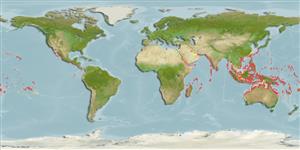Common names from other countries
>
Gobiiformes (Gobies) >
Gobiidae (Gobies) > Gobiinae
Etymology: Priolepis: Greek, prio = to saw + Greek,lepis = scale (Ref. 45335); semidoliata: Name from Latin semi meaning half and dolium for barrel, presumably a comparison of the barred colored pattern extending halfway down the body to the hoops of a barrel; noun in apposition..
More on author: Valenciennes.
Environment: milieu / climate zone / depth range / distribution range
Ecologia
marinhas associadas(os) a recifes; não migratória; intervalo de profundidade 2 - 30 m (Ref. 58302). Tropical; 30°N - 35°S
Indo-Pacific: Red Sea to Johnston Island and Pitcairn, north to Japan, south to Australia. Replaced by Priolepis farcimen in the Hawaiian Islands (Ref. 37816).
Tamanho / Peso / Idade
Maturity: Lm ? range ? - ? cm
Max length : 2.4 cm SL macho/indeterminado; (Ref. 1602)
Descrição suscinta
Chaves de identificação | Morfologia | Morfometria
Espinhos dorsais (total) : 7; Raios dorsais (total) : 8; Espinhos anais: 1; Raios anais : 7. Scales mostly restricted to the abdomen. Has relatively wide (> or = pupil diameter) light bars from the snout to the pectoral base, and few if any scales anterior of the operculum. Very similar to P. farcimen.
Benthic in caves and crevices of seaward reefs (Ref. 58302).
Ciclo de vida ou comportamento de acasalamento
Maturities | Reprodução | Spawnings | Egg(s) | Fecundities | Larvas
Winterbottom, R. and M. Burridge, 1993. Revision of the species of Priolepis possessing a reduced transverse pattern of cheek papillae and no predorsal scales (Teleostei; Gobiidae). Can. J. Zool. 71:494-514. (Ref. 9018)
Status na Lista Vermelha da UICN (Ref. 130435)
CITES (Ref. 128078)
Not Evaluated
Ameaça para os humanos
Harmless
Uso pelos humanos
Pescarias: espécies comerciais; Aquário: Espécies comerciais
Ferramentas
Relatórios especiais
Baixar XML
Fontes da internet
Estimates based on models
Preferred temperature (Ref.
115969): 24.6 - 29.3, mean 28.2 (based on 3287 cells).
Índice de diversidade filogenética (Ref.
82804): PD
50 = 0.5000 [Uniqueness, from 0.5 = low to 2.0 = high].
Bayesian length-weight: a=0.01023 (0.00477 - 0.02194), b=3.02 (2.84 - 3.20), in cm Total Length, based on LWR estimates for this (Sub)family-body shape (Ref.
93245).
Nível Trófico (Ref.
69278): 3.1 ±0.3 se; based on size and trophs of closest relatives
Resiliência (Ref.
120179): Elevada, tempo mínimo de duplicação da população menor que 15 meses (Preliminary K or Fecundity.).
Fishing Vulnerability (Ref.
59153): Low vulnerability (10 of 100).
